I’ve compiled a list of my best-performing grayling flies for January to help with the often challenging fishing conditions at this time of year.
January is a month of changeable weather conditions, especially when the prevailing weather switches from the southwest to the northeast. For example, I’ve experienced temperatures from a balmy 13oC to a bitterly freezing -10oC and lower while fishing on the Welsh Dee.
I’ve learned the hard way to avoid fishing the Welsh Dee when the…
daytime temperature is forecast to stay below freezing.
Because you’ll spend most of the time de-icing your rod rings and your body parts!
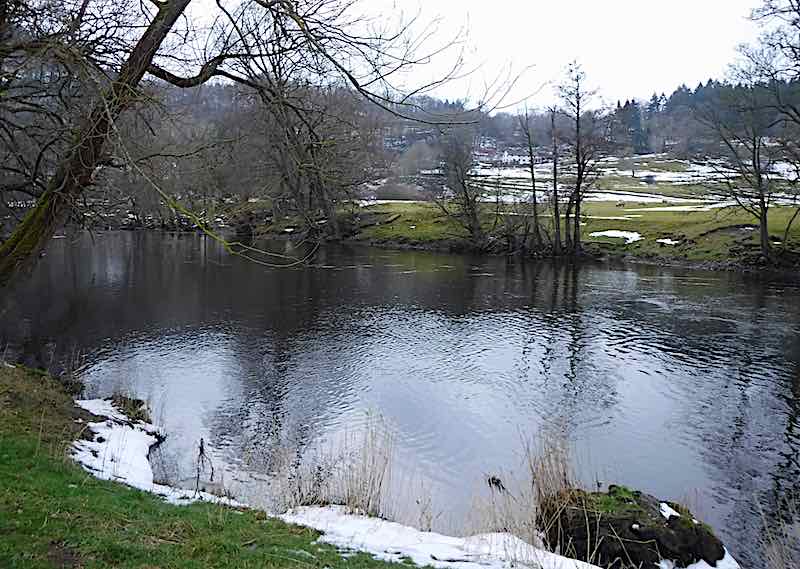
Fortunately, low-temperature extremes are rare. The long-term historical average temperature for Llangollen in January is a daytime high of 7oC and a night-time low of 2oC.
Fly hatches are often sparse on the Welsh Dee during January and are limited to the warmest time of the day; usually, between 12 and 2 pm. Other than that, grayling will be searching the riverbed for food: nymphs, larvae, worms etc.
So, how does all of the above affect…
My “Go-To” Grayling Flies for January?
I have a small data set in my fishing log for January compared to other months. Therefore, January fly selection is based on a combination of data and experience of fishing the Welsh Dee in difficult weather conditions.
By January on the Welsh Dee, grayling have shoaled into the large pools, which provide shelter when the river is in flood. Therefore, I focus on fishing the following pools at Llangollen:
A) Grayling flies for January when the river level is above 0.7m
In January, more often than not, the Welsh Dee is likely to be above 0.7m (Manley Hall gauge), and my fly selection primarily depends on water clarity.
Grayling nymphs for coloured water:
When the Welsh Dee is high and coloured, it’s necessary to fish a team of brightly coloured nymphs close to the riverbed.
To get down through deep water quickly I often use a very heavy point fly, such as a…
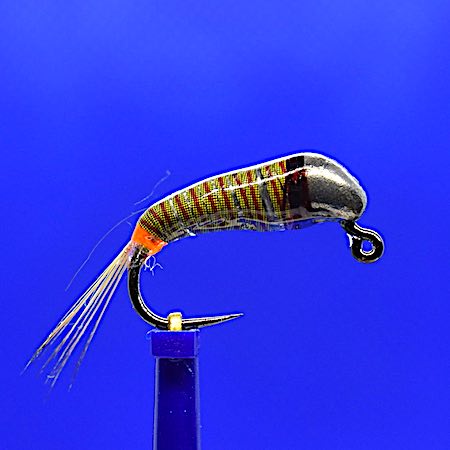
Olive Tungsten Jig-back
- Hook: Hends BL154 (#12)
- Weight: XL-tungsten jig-back
- Tail: Badger cock hackle fibres
- Tag: Fluorescent orange floss
- Body: Olive synthetic quill
- Thread: Claret UNI-Thread 8/0
- Coating: UV – Varnish:
I use the following flies on the middle and top droppers because they consistently catch fish when the river is coloured.
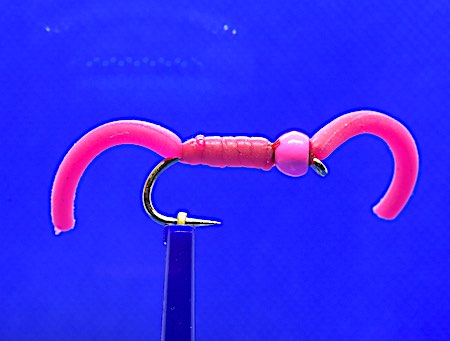
Pink Squirmy Worm
- Hook: Kamasan B100 #14 & 12
- Bead: 3.5 mm pink tungsten
- Thread: pink UNI-Thread 8/0
- Body: Pink squirmy

Pheasant tail Nymph
- Hook: Hends BL154 #14 & 12
- Bead: 3.5mm silver tungsten
- Thread: brown UNI-Thread 8/0
- Tag: Fluorescent orange thread
- Body & tail: Pheasant tail
- Rib: medium copper wire
- Thorax: medium olive dubbing
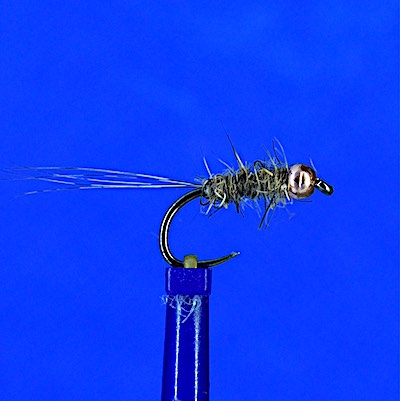
Hare’s Ear Nymph
- Hook: Hends BL154 (#14 & 16)
- Bead: 2.5mm gold tungsten
- Thread: tan UNI-Thread 8/0
- Tail: Coq de Leon
- Body: Hare’s Ear dubbing
- Rib: Fine copper wire
Clear water grayling flies for January:
I fish patterns that resemble natural nymphs when the river is high and clear in January.
When fish are not taking flies near the surface I start fishing Czech/Euro nymphing.
I use the following flies on the middle and top droppers because they consistently catch fish in clear water.
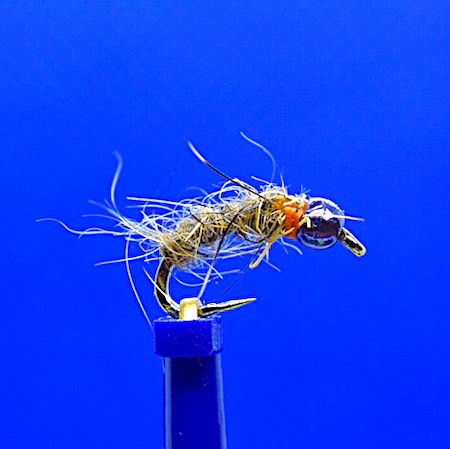
Purple beaded Hares Ear nymph
- Hook: Kamasan B100 #16 & 14
- Bead: 2mm purple tungsten
- Thread: Rusty orange UNI-Thread 8/0
- Body: Hare’s Ear dubbing
- Rib: fine copper wire
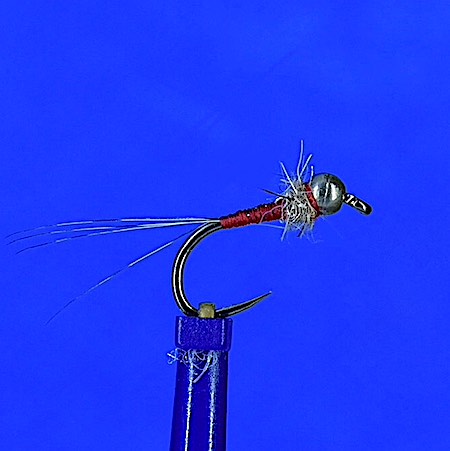
TB Claret nymph
- Hook: Hends BL154 (#14 & 16)
- Bead: 2mm tungsten
- Thread: Claret UNI-Thread 8/0
- Tail: Coq De Leaom
- Body: Claret UNI-Thread 8/0
- Thorax: Hends Dubbing HZ02
- Thorax cover: 1/32 Mylar tinsel
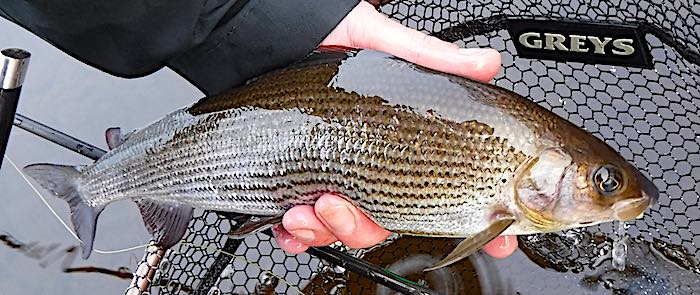
B) Grayling flies for January when the river level is below 0.7m
If the river is coloured and is below 0.7m, then I typically use the flies described in the section above for high and coloured water. The only change to that would be reducing the weight of the point fly so that it still bounces along the riverbed.
Finally, when the river is running clear and close to its summer level, the best approach often varies with the time of day.
At the start of the day, fishing nymphs close to the riverbed is usually the best approach. The nymphs described for clear high water conditions work well but with a much lighter point fly, for example, a purple collar PTN.
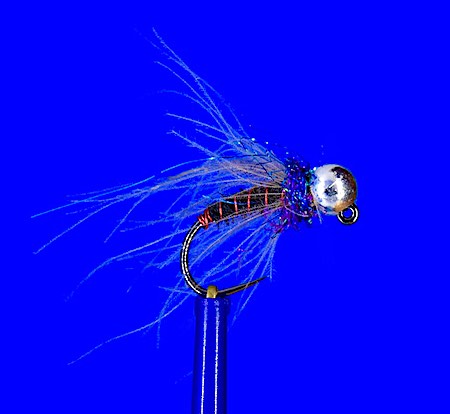
Purple collar black PTN
- Hook: Hends BL154 (#12 & 14)
- Bead: 3 or 3.5mm silver tungsten
- Thread: black UNI-Thread 8/0
- Body: black pheasant tail
- Rib: fine red wire
- Hackle: CDC feather
- Collar: Veniard glister sparkle purple dubbing
As the day progresses, be vigilant for signs of fish taking flies near the surface. When that happens, switching to fishing spiders, wet flies, or dry flies is often a good move.
January’s spider/wet fly selection for grayling:
My default grayling wet fly recommendation for January would be a three-fly cast on a 3lb copolymer leader (point: #14, black hopper; middle dropper: #14, pearl-ribbed March Brown spider; top dropper: #16, Pearly butt Waterhen Bloa).

Black Hopper
- Hook: Kamasan B170 #14
- Body: Black UNI-Thread 8/0
- Rib: Pearl Mylar #14 (1/32)
- Legs: Black pheasant tail
- Hackle: Black Hen
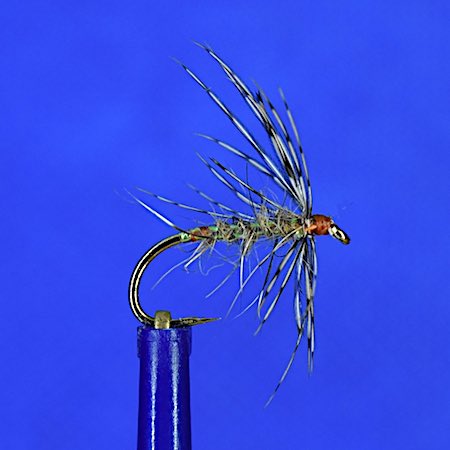
Pearl-ribbed March Brown Spider
- Hook: Kamasan B170 #14
- Body: Tan UNI-Thread 8/0
- Rib: Pearl Mylar #14 (1/32)
- Hackle: Brown partridge neck
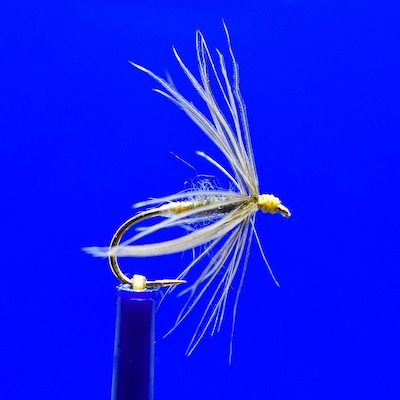
Pearly butt Watehen Bloa
- Hook: Kamasan B170 #14 & #16
- Thread: waxed primrose silk
- Butt: Pearl Mylar tinsel
- Body: lightly dubbed mole fur
- Hackle: Waterhen wing slip
Where best to fish the wet flies for grayling?
When the Welsh Dee is close to its summer level (<0.5m Manley Hall gauge), I focus my fishing in the following areas:
- the fast water leading into pools;
- alongside weed beds, large rocks, ledges, and snags;
- the glide leading into the tail of the pool
Check out the dedicated page for more on how I fish wet flies.
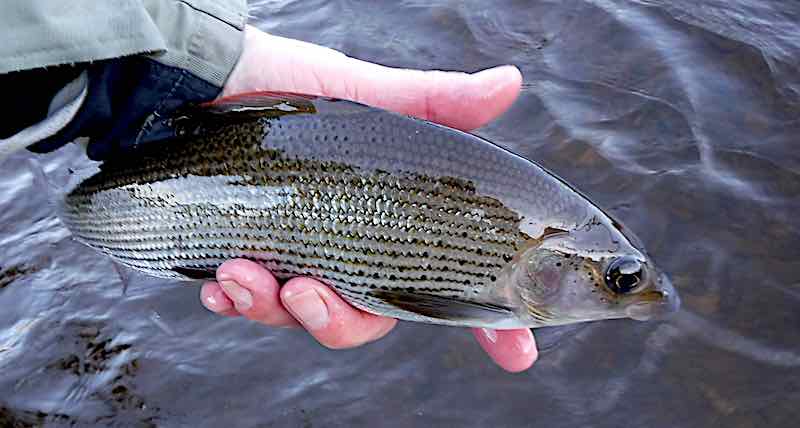
Grayling dry flies for January
On mild days in January, it is possible to see large dark olives hatching around mid-day. For these occasions, it’s wise to tie on a Jingler fly for some early-season dry fly fishing.
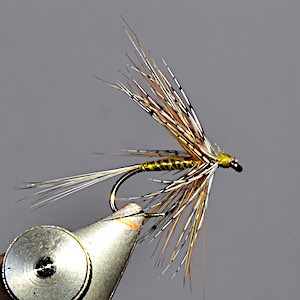
Jingler fly
- Hook: Kamasan B170 #14 & 12
- Thread: Olive 8/0 Uni-Thread
- Tail: Badger cock fibres
- Body: Hends body quill BQ-32
- Rear hackle: Ginger cock
- Front hackle: Grey partridge
All the above advice came from my records of flies that have reliably caught grayling in January, thus a great starting point for a newcomer to
The following list of posts provides more on fly fishing in winter that you should find interesting.
- Winter fly fishing for grayling: Great tips for beginners
- Grayling fishing at Rhagatt Hall – Out with the Old and in with the New Year
- Grayling fishing at Llandderfel – a great day on the Welsh Dee
If you are interested in fishing on the Welsh Dee there is some excellent day ticket water at Llangollen, Bala and Bangor on Dee.
Finally, I hope you enjoyed this post covering my best grayling flies for January and it would be great if you could share your favourite flies.

HI, Andrew – many thanks for yet another first class article. I forward these to my pal Colin who fishes the Harrogate Fly Fishers waters on the R.Nidd, where Grayling are making a come back along with Brown Trout. Best wishes and “Tight Lines” for 2021. Alan.
Hi Alan,
Great to hear you enjoyed the article and forwarded it to your friend.
Cheers, Andrew
Hi Andrew and a HNY to you.
Since subscribing to your blogs, they are becoming my go-to reads.
Your writing is clear and concise and you take the trouble to explain everything very clearly, including excellent fly tying technique links.
I am applying the grayling tactics and methods to my parts of the R.Dove in Derbyshire and so far am enjoying success using Euro nymphing and French leader approaches. I’m going to start also deploying the up & downstream wet fly, using spiders alot more also…just got to tie up a few more for my box!
For the future, I’d be interested on your take on using mini-streamers to target big browns. I’ve tried it here and had a couple of savage takes which unfortunately I haven’t managed to convert into a hooked fish, as yet.
Carry on the good work …I am hoping to get a chance on the R.Dee in 2022.
BW
Charles
Hi Charles,
Thanks for the great feedback on my fishing blog and I’m glad some of the information is helping you catch more fish on the River Dove.
On the Welsh Dee I use streamers when the river is unfishable using conventional methods and I have written a post on that https://hawker-overend.com/fly-fishing-with-streamers-for-trout-on-rivers/ Not sure how useful it will be for the Dove. I am experimenting with fishing small streamers on a nymphing rod and plan to write a post on that when I’ve mastered it.
Tight lines, Andrew
Hi Andrew,
I have been reading your excellent articles for a while now. The result is that I now am planning atrip to Llangollen…
Thank you for your clear and concise descriptions,
Howard
Hi Howard,
If you have some flexibility for your trip to fish the Dee at Llangollen. I would wait until the river level drops below 0.6m on the Manley Hall gauge https://riverlevels.uk/dee-erbistock-community-manley-hall#.VrdAWYbfXCQ because this allows you to fish most of the beat. Currently, the river is close to 2m and unfishable.
Great to hear you are enjoying my blog post.
Cheers, Andrew
Another excellent selection, thanks. I’ll try some on the Annan when the water drops.
Hi Steve,
Great to hear you enjoyed it. Would be good to know how any of the flies work on the Annan.
Tight lines, Andrew
Hi Andrew,
another excellent blog and very useful to anyone that does not get to fish the Dee very often. I shall be on a pairs match at Llangollen in late February so I will definitely be going through all your blogs and U tubes before attending.
How was your trip to Italy? Best wishes and tight lines. Iain Fraser.
Hi Iain,
We had a great holiday in southern Italy, it was warm and sunny all week, with lots of delicious food and wine. Now back to the cloud and rain. I hope the weather dries up for your visit in late February.
Thanks for the feedback on the post. Tight lines, Andrew
Hi Andrew, Many thanks for this post on the January flies and general chat. Enjoyed, too, your spell on the Lancashire Calder. I hope to have a go on the PAAS stretches by Whalley sometime in the next couple of months.
Keep well and tight lines,
Chris
Hi Chris,
The PAAS beats are good for the fly. I’ve had some nice grayling and trout out of them.
Tight lines, Andrew